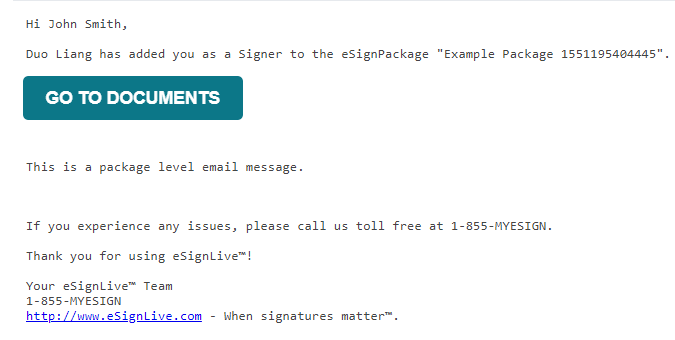To download the full code sample see our Code Share site.
When sending transactions for signing you can fully customize the emails your signers receive. Customization can be applied on both the Transaction level, and by Signer.
Customizing emails by transaction
You can add a transaction level message for all signers in the transaction. The following code will do this.
DocumentPackage pkg = PackageBuilder.newPackageNamed("Example Package " + System.currentTimeMillis()).withEmailMessage("This is a package level email message.").......build();
Customizing emails by Signer
You can add a transaction level message for each signer in the transaction. Signer level messages override the transaction level message. The following code will do this.
Signer signer2=SignerBuilder.newSignerWithEmail("[email protected]") .withEmailMessage("This is a signer level email message for signer2.") ...... .build();
Customizing emails by transaction and Signer
The following code will customize messages at both the transaction level, and by signer.
DocumentPackage pkg1 = PackageBuilder.newPackageNamed("Example Package " + System.currentTimeMillis()) .withSigner(SignerBuilder.newSignerWithEmail("[email protected]" ) .withFirstName("John") .withLastName("Smith")) .withSigner(SignerBuilder.newSignerWithEmail("[email protected]" ) .withFirstName("Marry") .withLastName("Doe") .withEmailMessage("This is a signer level email message for signer2.")) .withDocument(DocumentBuilder.newDocumentWithName("document 1") .fromFile("P:\\Documents\\documents-example\\Test PDF.pdf") .withSignature(SignatureBuilder.signatureFor("[email protected]") .onPage(0) .atPosition(100, 100) .withSize(250, 75)) .withSignature(SignatureBuilder.signatureFor("[email protected]") .onPage(0) .atPosition(200, 100) .withSize(250, 75))) .withEmailMessage("This is a package level email message.") .build();
Results
Here is an example of what you can expect to see once you have run your code.

Signer2:

To download the full code sample see our Code Share site.
When sending transactions for signing you can fully customize the emails your signers receive. Customization can be applied on both the Transaction level, and by Signer.
Customizing emails by transaction
You can add a transaction level message for all signers in the transaction. The following code will do this.
DocumentPackage pkg = PackageBuilder.NewPackageNamed("Example Package " + System.DateTime.Now) .WithEmailMessage("This is a package level email message.") ...... .Build();
Customizing emails by Signer
You can add a transaction level message for each signer in the transaction. Signer level messages override the transaction level message. The following code will do this.
Signer signer2 = SignerBuilder.NewSignerWithEmail("[email protected]") .WithEmailMessage("This is a signer level email message for signer2.") ...... .Build();
Customizing emails by transaction and Signer
The following code will customize messages at both the transaction level, and by signer.
DocumentPackage pkg1 = PackageBuilder.NewPackageNamed("Example Package " + System.DateTime.Now) .WithSigner(SignerBuilder.NewSignerWithEmail("[email protected]" ) .WithFirstName("John") .WithLastName("Smith")) .WithSigner(SignerBuilder.NewSignerWithEmail("[email protected]" ) .WithFirstName("Marry") .WithLastName("Doe") .WithEmailMessage("This is a signer level email message for signer2.")) .WithDocument(DocumentBuilder.NewDocumentNamed("document 1") .FromFile("P:\\Documents\\documents-example\\Test PDF.pdf") .WithSignature(SignatureBuilder.SignatureFor("[email protected]") .OnPage(0) .AtPosition(100, 100) .WithSize(250, 75)) .WithSignature(SignatureBuilder.SignatureFor("[email protected]") .OnPage(0) .AtPosition(200, 100) .WithSize(250, 75))) .WithEmailMessage("This is a package level email message.") .Build();
Results
Here is an example of what you can expect to see once you have run your code.

Signer2:

To download the full code sample see our Code Share site.
When sending transactions for signing you can fully customize the emails your signers receive. Customization can be applied on both the Transaction level, and by Signer.
Customizing emails by transaction
You can add a transaction level message for all signers in the transaction. The following code will do this.
HTTP Request
PUT /api/packages/{packageId}
HTTP Headers
Accept: application/json Content-Type: application/json Authorization: Basic api_key
Request Payload
{ "emailMessage": "Changed package level email message." }
Customizing emails by Signer
You can add a transaction level message for each signer in the transaction. Signer level messages override the transaction level message. The following code will do this.
HTTP Request
POST /api/packages/{packageId}/roles
HTTP Headers
Accept: application/json Content-Type: application/json Authorization: Basic api_key
Request Payload
{
"emailMessage": {
"content": "Please sign the documents ASAP."
}
,
"id": "Signer5",
"reassign": true,
"type": "SIGNER",
"signers": [ { "email": "[email protected]", "firstName": "John", "lastName": "Smith", "id": "Signer5" } ],
"name": "Signer5"
}
For a complete description of each field, see the Request Payload table below.
Response Payload
{
"id": "Signer5",
"data": null,
"specialTypes": [],
"emailMessage": {
"content": "Please sign the documents ASAP."
}
,
"attachmentRequirements": [],
"locked": false,
"reassign": true,
"index": 0,
"signers": [ { "group": null, "language": "en", "signature": null, "id": "Signer5", "delivery": { "provider": false, "email": false, "download": false } , "auth": { "scheme": "NONE", "challenges": []
}
,
"knowledgeBasedAuthentication": null,
"data": null,
"title": "",
"company": "",
"email": "[email protected]",
"firstName": "John",
"lastName": "Smith",
"external": null,
"updated": "2017-11-16T16:53:01Z",
"phone": "",
"professionalIdentityFields": [],
"userCustomFields": [],
"address": null,
"created": "2017-11-16T16:53:01Z",
"name": "",
"specialTypes": []
}
],
"name": "Signer5",
"type": "SIGNER"
}Results
Here is an example of what you can expect to see once you have run your code.

Request Payload Table
| Property | Type | Editable | Required | Default | Sample Values |
|---|---|---|---|---|---|
| Property | Type | Editable | Required | Default | Sample Values |
| id | string | Yes | No | n/a | Signer5 |
| emailMessage | |||||
| content | string | Yes | No | n/a | Please sign the documents ASAP. |
| name | string | Yes | No | n/a | Signer5 |
| id | string | Yes | No | n/a | Signer5 |
| type | string | Yes | No | SIGNER | SIGNER / SENDER |
| signers | |||||
| string | Yes | No | n/a | [email protected] | |
| firstName | string | Yes | No | n/a | John |
| lastName | string | Yes | No | n/a | Smith |
| id | string | Yes | No | n/a | Signer5 |